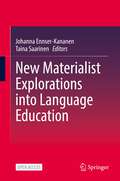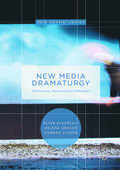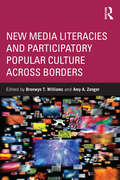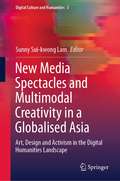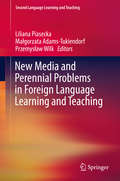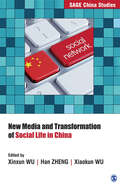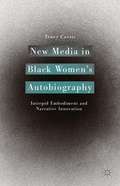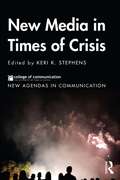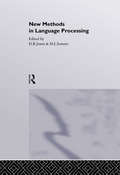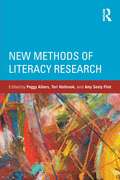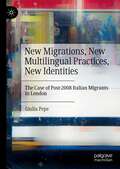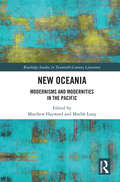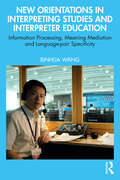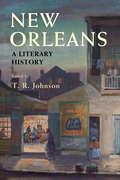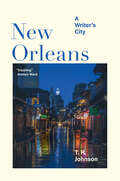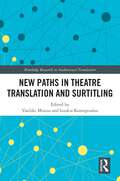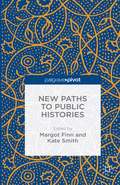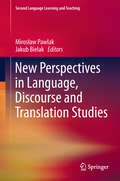- Table View
- List View
New Masculinities in Contemporary German Literature: From ‘‘Native’’ to Transnational (Global Masculinities)
by Frauke MatthesThe complex nexus between masculinity and national identity has long troubled, but also fascinated the German cultural imagination. This has become apparent again since the fall of the Iron Curtain and the turn of the millennium when transnational developments have noticeably shaped Germany’s self-perception as a nation. This book examines the social and political impact of transnationalism with reference to current discourses of masculinity in novels by five contemporary male German-language authors. Specifically, it analyses how conceptions of the masculine interact with those of nationality, ethnicity, and otherness in the selected texts and assesses the new masculinities that result from those interactions. Exploring how local discourses of masculinity become part of transnational contexts in contemporary writing, the book moves a consideration of masculinities from a "native" into a transnational sphere.
New Materialist Explorations into Language Education
by Johanna Ennser-Kananen Taina SaarinenThis open access book analyzes language education through a socio-material framework. The authors revisit their position as researchers by decentering themselves and humans in general from the main focus of research activities and giving way to the materialities that are agentive but often overlooked parts of our research contexts and processes. Through this critical posthumanist realism, they are able to engage in research that sees society as an ethical interrelationship between humans and the material world and explore the socio-materialities of language education from the perspectives of material agency, spatial and embodied materiality, and human and non-human assemblages. Each chapter explores language educational contexts through a unique lens of (socio)materiality. Based on how the authors conceptualize (socio)materiality, the book is organized in three sections that seek answers to the following overarching questions:In what ways do material agencies emerge in language educational contexts?How are educational choices and experiences intertwined with materialities of spaces and bodies? What assemblages of human and non-human may occur in language education contexts?Each chapter questions, in its own way, the notion of the human subject as rational, enlightened being and sole possessor of agency, and offers examples of allowing for other-than-human agency to enter the picture. Together, the contributors exemplify how researchers who have been committed to social constructionist thinking for most of their careers learn to make space for new theories, thus inspiring and encouraging readers to remain open for new intellectual and embodied endeavors.
New Media Dramaturgy
by Peter Eckersall Helena Grehan Edward ScheerThis book illuminates the shift in approaches to the uses of theatre and performance technology in the past twenty-five years and develops an account of new media dramaturgy (NMD), an approach to theatre informed by what the technology itself seems to want to say. Born of the synthesis of new media and new dramaturgy, NMD is practiced and performed in the work of a range of important artists from dumb type and their 1989 analog-industrial machine performance pH, to more recent examples from the work of Kris Verdonck and his A Two Dogs Company. Engaging with works from a range of artists and companies including: Blast Theory, Olafur Eliasson, Nakaya Fujiko and Janet Cardiff, we see a range of extruded performative technologies operating overtly on, with and against human bodies alongside more subtle dispersed, interactive and experiential media.
New Media Language
by Jean Aitchison Diana M. LewisNew Media Language brings leading media figures and scholars together to debate the shifting relations between today's media and contemporary language.From newspapers and television to email, the Internet and text messaging, there are ever increasing media conduits for news. This book investigates how developments in world media have affected, and been affected by, language. Exploring a wide range of topics, from the globalization of communication to the vocabulary of terrorism and the language used in the wake of September 11, New Media Language looks at the important and wide-ranging implications of these changes. From Malcolm Gluck on wine writing, to Naomi Baron on email, the authors provide authoritative and engaging insights into the ways in which language is changing, and in turn, changes us.With a foreword by Simon Jenkins, New Media Language is essential reading for anyone with an interest in today's complex and expanding media.
New Media Literacies and Participatory Popular Culture Across Borders
by Bronwyn T Williams Amy A ZengerHow do students’ online literacy practices intersect with online popular culture? In this book scholars from a range of countries including Australia, Lebanon, Nepal, Qatar, South Africa, Turkey, and the United States illustrate and analyze how literacy practices that are mediated through and influenced by popular culture create both opportunities and tensions for secondary and university students. The authors examine issues of theory, identity, and pedagogy as they address participatory popular culture sites such as fan forums, video, blogs, social networking sites, anime, memes, and comics and graphic novels. Uniquely bringing together scholarship about online literacy practices and the growing body of work on participatory popular culture, New Media Literacies and Participatory Popular Culture across Borders makes distinctive contributions to an emerging field of study, pushing forward scholarship about literacy and identity in cross-cultural situations and advancing important conversations about issues of global flows and local responses to popular culture.
New Media Spectacles and Multimodal Creativity in a Globalised Asia: Art, Design and Activism in the Digital Humanities Landscape (Digital Culture and Humanities #3)
by Sunny Sui-kwong LamThis edited volume aims to unpack the digitisation of art and media within the dynamics of participatory culture, and how these changes affect the power relations between the production and consumption of these new forms in a globalised Asia. This follows the rise of new art forms and social media platforms in wake of rapid and ongoing digitisation, which has, in turn, produced far-reaching implications for changing media ownership and its role in social, cultural, economic, as well as political activities. New challenges arise every day in relation to digital art and design practices and social media communications, and their respective impact on identity politics. This book showcases a diverse range of interdisciplinary research on these concomitant changes and challenges associated with digital media and technologies within the context of a globalised Asia. The case studies included present perspectives on Asia’s evolving digital humanities landscape from Hong Kong, China, India, Korea and from across Southeast Asia, with topics that tackle organisational digital marketing, brand advertising and design, mobile gaming, interactive art, and the cultural activities of ethnic and sexual minority communities in the region. This book will of interest to scholars in digital humanities focused on new media and cultural studies.
New Media and Perennial Problems in Foreign Language Learning and Teaching
by Liliana Piasecka Małgorzata Adams-Tukiendorf Przemysław WilkThe book concerns the ways in which the new media shape communication along with educational expectations and practices in foreign language classrooms. Although foreign language learners have cheap and easy access to information and ways of communication, they also wrestle with problems that have always accompanied language learning. The focus of the book is two-fold. On the one hand, the authors demonstrate how using social networks, videoconferencing, mobile phones, wikis, and computer-mediated interaction contributes to the development of language skills, negotiated interaction, autonomy, and intercultural competence. On the other, they discuss "old" issues pertaining to the role of vocabulary, corrective feedback, textbooks and inner speech in the process of language learning and use. Every chapter reports original empirical research on issues related to the new media and old problems in foreign language teaching contexts in various countries, and with respect to various age groups.
New Media and Transformation of Social Life in China (SAGE China Studies)
by Xinxun Wu Han Zheng Xiaokun WuThe field of media and communication has expanded substantially in China over the last few decades. New Media and the Transformations of Social Life in China covers in detail the main aspects related to media in China, including new media technologies, social networks, media convergence, smart cities, digital media, information and communication technology (ICT), and risk society. A major strength of this book is its coverage of the role of ICT for social participation in urban policy and management areas, which include e-governance, social security, and decision support systems. The book also addresses issues such as the financial crisis, the global energy crisis, and environmental pollution.
New Media in Black Women's Autobiography
by Tracy CurtisExamining novelists, bloggers, and other creators of new media, this study focuses on autobiography by American black women since 1980, including Audre Lorde, Jill Nelson, and Janet Jackson. As Curtis argues, these women used embodiment as a strategy of drawing the audience into visceral identification with them and thus forestalling stereotypes.
New Media in Times of Crisis (New Agendas in Communication Series)
by Keri K. StephensNew Media in Times of Crisis provides an interdisciplinary look at research focused around how people organize during crises. Contributors examine the latest practices for communicating during crises, including evacuation practices, workplace safety challenges, crisis social media usage, and strategies for making emergency alerts on U.S. mobile phones constructive and helpful. The book is grounded in the practices of first responders, crisis communicators, people experiencing tragic events, and communities who organize on- and offline to make sense of their experiences. The authors draw upon a wide range of theories and frameworks with the goal of establishing new directions for research and practice. The text is suitable for advanced students and researchers in crisis, disaster, and emergency communication.
New Media: A Critical Introduction
by Jon Dovey Seth Giddings Iain Grant Kieran Kelly Martin ListerNew Media: A Critical Introduction is a comprehensive introduction to the culture, history, technologies and theories of new media. Written especially for students, the book considers the ways in which 'new media' really are new, assesses the claims that a media and technological revolution has taken place and formulates new ways for media studies to respond to new technologies. The authors introduce a wide variety of topics including: how to define the characteristics of new media; social and political uses of new media and new communications; new media technologies, politics and globalization; everyday life and new media; theories of interactivity, simulation, the new media economy; cybernetics, cyberculture, the history of automata and artificial life. Substantially updated from the first edition to cover recent theoretical developments, approaches and significant technological developments, this is the best and by far the most comprehensive textbook available on this exciting and expanding subject. At www.newmediaintro.com you will find: additional international case studies with online references specially created You Tube videos on machines and digital photography a new ‘Virtual Camera’ case study, with links to short film examples useful links to related websites, resources and research sites further online reading links to specific arguments or discussion topics in the book links to key scholars in the field of new media.
New Men in Trollope's Novels: Rewriting the Victorian Male (The\nineteenth Century Ser.)
by Margaret MarkwickNew Men in Trollope's Novels challenges the popular construction of Victorian men as patriarchal despots and suggests that hands-on fatherhood may have been a nineteenth-century norm. Beginning with an evaluation of the evidence for cultural determinations of masculinity during Trollope's times, the author sets the stage with a discussion of the religious, philosophical, and educational influences that informed the evolution of Trollope's personal views of masculinity as he grew from boyhood into later manhood. Her treatment of his novels, drawing on a wide selection from across the oevre, shows that sensitive examination of Trollope's texts discovers him advancing a startlingly modern model of manhood under a veneer of conformity. Trollope's independent views on child-rearing, education, courtship, marriage, parenthood, and gay men are also discussed within the context of Victorian culture in this witty, original, and immensely knowledgeable study of Victorian masculinity.
New Methods In Language Processing
by H. L. Somers D. B. JonesStudies in Computational Linguistics presents authoritative texts from an international team of leading computational linguists. The books range from the senior undergraduate textbook to the research level monograph and provide a showcase for a broad range of recent developments in the field. The series should be interesting reading for researchers and students alike involved at this interface of linguistics and computing.
New Methods of Literacy Research
by Teri Holbrook Amy Seely Flint Peggy AlbersLiteracy researchers at all stages of their careers are designing and developing innovative new methods for analyzing data in a range of spaces in and out of school. Directly connected with evolving themes in literacy research, theory, instruction, and practices—especially in the areas of digital technologies, gaming, and web-based research; discourse analysis; and arts-based research—this much-needed text is the first to capture these new directions in one volume. Written by internationally recognized authorities whose work is situated in these methods, each chapter describes the origin of the method and its distinct characteristics; offers a demonstration of how to analyze data using the method; presents an exemplary study in which this method is used; and discusses the potential of the method to advance and extend literacy research. For literacy researchers asking how to match their work with current trends and for educators asking how to measure and document what is viewed as literacy within classrooms, this is THE text to help them learn about and use the rich range of new and emerging literacy research methods.
New Mexico McDougal Littell Literature: American Literature
by Arthur N. Applebee Jim Burke Janet AllenMcDougal Littell Literature: American Literature 2009 New Mexico Student's Edition.
New Migrations, New Multilingual Practices, New Identities: The Case of Post-2008 Italian Migrants in London
by Giulia PepeThis book presents an original empirical study on the linguistic repertoires of post-2008 Italian migrants living in London. The author interrogates how migrants’ trajectories and their relation with their homeland’s migration history are displayed through the engagement of new multilingual practices, such as translanguaging, and how new identities are negotiated during conversational acts. The book will be of interest to students and scholars of Sociolinguistics and Migration Studies.
New Oceania: Modernisms and Modernities in the Pacific (Routledge Studies in Twentieth-Century Literature #1)
by Matthew Hayward Maebh LongFor so long figured in European discourses as the antithesis of modernity, the Pacific Islands have remained all but absent from the modernist studies’ critical map. Yet, as the chapters of New Oceania: Modernisms and Modernities in the Pacific collectively show, Pacific artists and writers have been as creatively engaged in the construction and representation of modernity as any of their global counterparts. In the second half of the twentieth century, driving a still ongoing process of decolonisation, Pacific Islanders forged an extraordinary cultural and artistic movement. Integrating Indigenous aesthetics, forms, and techniques with a range of other influences — realist novels, avant-garde poetry, anti-colonial discourse, biblical verse, Indian mythology, American television, Bollywood film — Pacific artists developed new creative registers to express the complexity of the region’s transnational modernities. New Oceania presents the first sustained account of the modernist dimensions of this period, while presenting timely reflections on the ideological and methodological limitations of the global modernism rubric. Breaking new critical ground, it brings together scholars from a range of backgrounds to demonstrate the relevance of modernism for Pacific scholars, and the relevance of Pacific literature for modernist scholars.
New Orientations in Interpreting Studies and Interpreter Education: Information Processing, Meaning Mediation and Language-pair Specificity
by Binhua WangThis book proposes a multidimensional model that revisits the epistemology of interpreting studies and the distinctive features of interpreting, and outlines three new research orientations.The first considers interpreting as immediate bilingual information processing, the second considers interpreting as meaning mediation in cross-lingual interpersonal communication and cross-sociocultural interaction, and the third looks at language-pair specificity in interpreting. The main research topics, concepts and methods are covered, and case studies and examples are provided. The author also proposes a multicomposite framework of interpreter competence as the conceptual foundation of interpreter education in the AI era, for which three major shifts are identified as necessary, particularly the transition from interpreting skill training to interpreter competence development. The research orientations discussed in this book are important as they shed new light on the nature and mechanism of interpreting, open up new venues for interpreting studies and provide meaningful responses to new issues emerging from changes in the interpreting profession with the development of AI technologies. This is essential reading for all engaged in teaching, researching and studying interpreting and interpreting studies.
New Orleans: A Literary History
by T. R. JohnsonNew Orleans is an indispensable element of America's national identity. As one of the most fabled cities in the world, it figures in countless novels, short stories, poems, plays, and films, as well as in popular lore and song. This book provides detailed discussions of all of the most significant writing that this city has ever inspired - from its origins in a flood-prone swamp to the rise of a creole culture at the edges of the European empires; from its emergence as a cosmopolitan, hemispheric crossroads and a primary hub of the slave trade to the days when, in its red light district, the children and grandchildren of the enslaved conjured a new kind of music that became America's greatest gift to the world; from the mid-twentieth-century masterpieces by William Faulkner, Tennessee Williams and Walker Percy to the realms of folklore, hip hop, vampire fiction, and the Asian and Latin American archives.
New Orleans: A Writer's City (Imagining Cities)
by T. R. JohnsonThe neighborhoods of New Orleans have given rise to an extraordinary outpouring of important writing. Over the last century and a half or so, these stories and songs have given the city its singular place in the human imagination. This book leads the reader along five thoroughfares that define these different parts of town – Royal, St. Claude, Esplanade, Basin, and St. Charles – to explore how the writers who have lived around them have responded in closely related ways to the environments they share. On the outskirts of New Orleans today, the city's precarious relation to its watery surroundings and the vexed legacies of race loom especially large. But the city's literature shows us that these themes have been near to hand for New Orleans writers for several generations, whether reflected through questions of masquerade, dreams of escape, the innocence of children, or the power of money or of violence or of memory.
New Paths in Theatre Translation and Surtitling (Routledge Research in Audiovisual Translation)
by Vasiliki Misiou Loukia KostopoulouThis collection provides an in-depth exploration of surtitling for theatre and its potential in enhancing accessibility and creativity in both the production and reception of theatrical performances.The volume collects the latest research on surtitling, which encompasses translating lyrics or sections of dialogue and projecting them on a screen. While most work has focused on opera, this book showcases how it has increasingly played a role in theatre by examining examples from well-known festivals and performances. The 11 chapters underscore how the hybrid nature and complex semiotic modes of theatrical texts, coupled with technological advancements, offer a plurality of possibilities for applying surtitling effectively across different contexts. The book calls attention to the ways in which agents in theatrical spaces need to carefully reflect on the role of surtitling in order to best serve the needs of diverse audiences and produce inclusive productions, from translators considering appropriate strategies to directors working on how to creatively employ it in performance to companies looking into all means available for successful implementation. Offering a space for interdisciplinary dialogues on surtitling in theatre, this book will be of interest to scholars in audiovisual translation, media accessibility, and theatre and performance studies.
New Paths to Public Histories
by Margot Finn Kate SmithNew Paths to Public Histories challenges readers to consider historical research as a collaborative pursuit enacted across a range of individuals from different backgrounds and institutions. It argues that research communities can benefit from recognizing and strengthening the ways in which they work with others.
New Perspectives in Language, Discourse and Translation Studies
by Mirosław Pawlak Jakub BielakThe current volume is a collection of papers representing the most recent developments in linguistics, specifically in the fields of language, discourse and translation studies. It includes papers representative of traditionally distinguished linguistic subdisciplines such as phonetics and phonology, morphology and syntax, historical linguistics, pragmatics, discourse analysis and sociolinguistics, as well as translation. Since the contributions contained in the book touch upon such a variety of disciplines and do so from both more traditional and more innovative perspectives, it will be an important point of reference for scholars, graduate students and lecturers teaching courses in linguistics.
New Perspectives in Media Translation: Transcreation in the Digital Age
by Loukia Kostopoulou Parthena CharalampidouThis edited book explores the practice of transcreation in a variety of contexts, from audiovisual material to digital and marketing material. Drawing on the latest developments in translation and media studies, the volume promotes an understanding of the transcreation process and the way it challenges the concept of translation (Chaume 2018) and impacts on training for translators, localizers and content creators. Chapters include both theoretical and experimental research contributions that investigate facets of transcreation in diverse media and genres and offer constructive insights in the discipline. This book covers the theoretical aspects and practices of transcreation in audiovisual and digital media and will appeal to scholars, researchers and professionals working in the fields of translation, especially audiovisual translation, transcreation, localization and new media.

